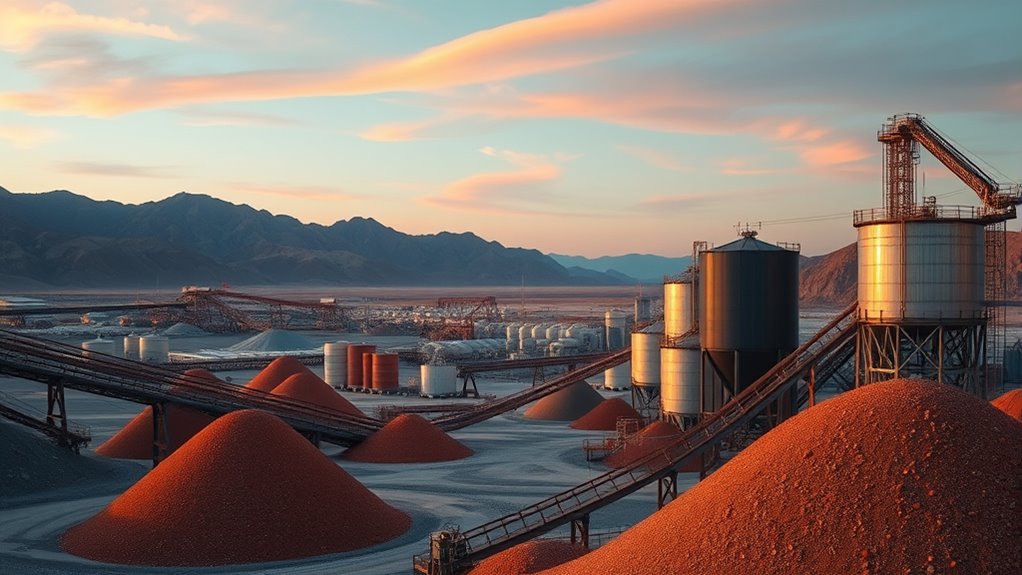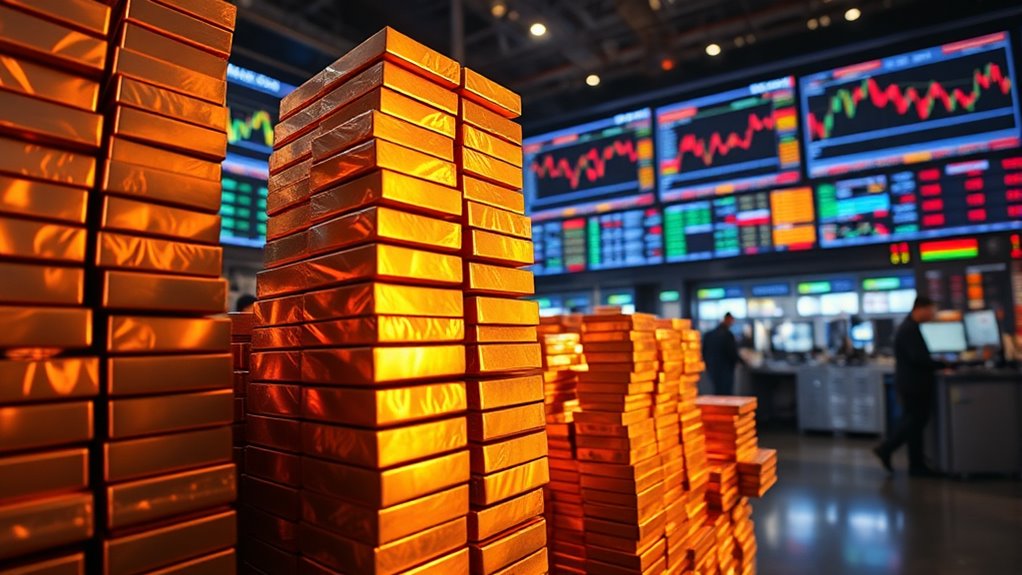The commodities supercycle for 2025 looks promising as demand for critical metals like lithium, cobalt, nickel, and rare earths surges due to the global shift to renewables and electric vehicles. Supply constraints, geopolitical tensions, and investment trends support higher prices, while policies and environmental challenges add complexity. If you want to understand how these factors could shape a long-term metals boom, there’s more to uncover below.
Key Takeaways
- Rising global demand for lithium, cobalt, nickel, and rare earths driven by renewable energy and EV growth indicates a potential supercycle.
- Supply constraints from underinvestment and geopolitical tensions may tighten metal markets, fueling price increases.
- Investor interest in transition metals and commodities as inflation hedges supports the outlook for a metals boom.
- Policy shifts toward green tech and ESG regulations could both boost demand and limit supply expansion.
- Persistent macroeconomic inflation and safe-haven demand for gold and silver reinforce a bullish commodities environment through 2025.
Key Drivers Behind the 2025 Cycle

The 2025 commodities supercycle is primarily driven by the global energy shift, which markedly boosts demand for metals like lithium, cobalt, nickel, copper, and rare earths. This progression to renewables, electric vehicles, and green technologies is creating a long-term surge in metal consumption. Meanwhile, rapid urbanization and industrialization in emerging markets, especially in BRICS+ countries, push demand for construction and energy metals higher. Technological advancements such as AI, robotics, and data centers also require significant metal inputs, fueling further growth. Additionally, population increases and rising incomes in developing nations amplify consumption of energy, food, and consumer goods. Coupled with underinvestment in mining and geopolitical tensions, these factors cause persistent supply constraints, supporting sustained price increases and shaping the supercycle’s foundation. Moreover, the limited diversity of biodiversity in some critical mining regions can impact ecological stability and resource availability over the long term.
Rising Demand for Critical Metals

As demand for energy and industrial metals accelerates, the spotlight turns to critical metals like lithium, cobalt, nickel, and rare earth elements. You’ll notice that the shift to electric vehicles (EVs), renewable energy tech, and smart devices drives this surge. Lithium demand surged nearly 30% in 2024 alone, fueling fears of supply shortages. Cobalt and nickel are essential for battery production, but their limited supply chains face growing pressure from expanding markets. Rare earth elements, essential for green tech and electronics, are heavily controlled by China, raising geopolitical concerns. As industries pivot toward cleaner, smarter solutions, your investments and supply chain strategies must adapt to meet this rising demand. Persistent underinvestment and geopolitical risks make these critical metals central to the upcoming supercycle.
Market Dynamics and Investment Trends

Market dynamics in 2025 are increasingly driven by robust investor interest and shifting asset allocations toward commodities, especially metals essential for the energy transition. You’ll notice that the Bloomberg Commodity Index and transition metals index have gained considerably, reflecting heightened confidence in commodities’ long-term growth. Gold and silver mining stocks nearly doubled this year, as investors seek safe havens amid inflation and volatility. Meanwhile, traditional portfolios like 60/40 are facing challenges, prompting more capital to flow into commodities for diversification. Central banks are increasing gold holdings, and retail investors are buying metals to hedge inflation. As geopolitical tensions and supply constraints persist, prices remain supported, and investors are increasingly viewing commodities as indispensable assets in balancing risk and capitalizing on the supercycle’s momentum. Understanding market trends can further inform long-term investment strategies amid these developments.
Policy and Economic Influences

Policy and economic factors are actively shaping the trajectory of the 2025 commodities supercycle by influencing supply, demand, and investment flows. Persistent inflation limits central banks’ ability to cut interest rates, supporting higher commodity prices. Rising global policy uncertainty, trade tensions, and geopolitical conflicts increase safe-haven demand for precious metals like gold and silver. Climate change policies and the push for green technology drive large-scale capital reallocation into mining and metals, even as ESG pressures raise operational costs. Meanwhile, inflationary pressures boost energy and food prices, with policies impacting supply chains and production. Overall, government actions and macroeconomic trends are creating a favorable environment for commodities, bolstering long-term demand and constraining supply, which sustains the upward price momentum characteristic of this supercycle. Additionally, juice cleansing practices highlight how dietary trends are influenced by health-related choices, reflecting broader shifts in consumer behavior that can impact commodity markets indirectly.
Potential Risks and Future Outlook

While the long-term outlook for the commodities supercycle remains promising, several risks could disrupt this trajectory. Supply shortages may worsen if new mining projects face delays or opposition, creating persistent deficits. Geopolitical tensions and resource nationalism threaten to disrupt supply chains and cause volatility. ESG pressures and environmental regulations might slow project approvals and increase costs for mining companies. Additionally, climate change could lead to extreme weather events, damaging agricultural and mining operations. You should also watch for potential economic shifts, like a slowdown in emerging markets or a transition back to value stocks, which could dampen commodity demand. Moreover, fluctuations in projector technology and consumer preferences could impact demand for certain materials. Keep in mind these risks may lead to sharp price swings, making the supercycle less predictable and more challenging to navigate.
Frequently Asked Questions
How Long Is the Expected Duration of the 2025 Commodities Supercycle?
You can expect the 2025 commodities supercycle to last at least a decade, possibly longer. This prolonged period is driven by structural shifts like energy shift, technological advances, and rising demand from emerging markets. Supply constraints and geopolitical tensions will likely sustain higher prices, keeping the cycle alive. Keep in mind, external factors like policy changes or technological breakthroughs could influence its duration, but the trend points to a multi-year, if not multi-decade, upward trajectory.
Which Specific Regions Are Most Impacted by Supply Chain Disruptions?
You’ll find that China and other emerging markets are most impacted by supply chain disruptions. China dominates rare earths and critical metals, making its supply chains vulnerable to geopolitical tensions and export restrictions. Meanwhile, regions like Africa and Latin America face infrastructure challenges, political instability, and underinvestment that hinder mining operations. These factors cause delays, increase costs, and amplify shortages, which can drive up prices and further strain global supply networks.
What Role Do Technological Innovations Play in Accelerating Demand?
Imagine a wildfire spreading rapidly, fueled by technological innovations, tearing through the landscape of demand. You see AI, robotics, and data centers igniting a fierce appetite for metals like copper, lithium, and rare earths. These breakthroughs act as accelerants, transforming industries and creating a surge of need for resources. As technology advances, it drives demand higher, turning supply chains into battlegrounds and pricing into a rollercoaster ride.
How Might Changing Government Policies Influence Metal Supply Stability?
Changing government policies can considerably impact metal supply stability by influencing mining regulations, environmental standards, and investment incentives. You might see stricter ESG requirements slow down new projects or increase costs, while supportive policies can boost exploration and development. Trade restrictions or resource nationalism could disrupt supply chains, causing shortages and price volatility. Staying aware of policy shifts helps you anticipate supply risks and adjust your investment strategies accordingly.
Are There Emerging Commodities That Could Trigger the Next Supercycle?
You might find yourself surprised, but emerging commodities like rare earth elements, lithium, and cobalt could trigger the next supercycle. As electric vehicles, renewable energy tech, and digital innovations accelerate, demand for these materials surges. Coincidentally, supply struggles and geopolitical risks heighten their scarcity. If investments and policies align, these critical resources could fuel a long-term boom, reshaping markets and creating new opportunities for savvy investors like you.
Conclusion
As you watch these evolving trends, one thing’s clear: the next commodities supercycle could reshape markets in ways you haven’t imagined. Will demand for critical metals skyrocket faster than expected? Or will unforeseen risks slow the momentum? The future remains uncertain, but staying alert now could give you the edge. The question is, are you prepared for the surprises that 2025 might hold? The answer could define your next move.









